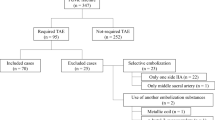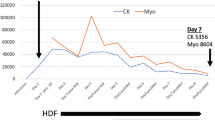Abstract
Background: Transcatheter arterial embolization (TAE) can cause gluteal skin and muscle necrosis. However, the ultimate and typical signs of gluteal necrosis resulting from TAE have not yet thoroughly been investigated.
Methods: From January 1995 to December 2003, 165 pelvic fractures were managed with TAE to control retroperitoneal bleeding at our level 1 trauma center. From these, 12 patients suffered gluteal muscle and skin necrosis. We reviewed the medical records of these 12 patients for age, gender, fracture type, embolic sites, computed tomography (CT) findings, serum creatine kinase level, site of skin necrosis, time from injury to skin necrosis, treatment, and outcome.
Results: All 12 patients underwent TAE of the bilateral internal iliac arteries with gelatin sponge slurries. One patient suffered from an infection of the gluteal muscle from an open fracture site. Five patients presented with signs of gluteal soft tissue injuries on admission. Of these, four had skin abrasions and three revealed fluid or air collection under the gluteal skin on CT. The remaining six patients showed no evidence of soft tissue injuries on admission, and the lesions appeared between 2 days and 7 days after their admission. In these six patients, low-density areas (LDAs) of gluteal muscle with a clear border on the CT were observed following the appearance of skin lesion. The skin necrosis was located in the center of either or both buttocks, and signs of ischemia were clearly demarcated from the adjacent normal tissue. Four of 12 patients died from sepsis, three of whom suffered from uncontrollable gluteal infections that had been pointed out as LDAs on the CT.
Conclusions: In every patient with gluteal necrosis associated with pelvic fracture following TAE, initial traumatic contusion cannot be ruled out as contributing to the development of the necrosis. However, for patients who undergo TAE of the bilateral internal iliac artery and who show clear-border LDAs on CT, skin necrosis centered on the buttock, and the delayed appearance of a skin lesion, careful attention must be given in the event of an arterial obstruction due to TAE.


Similar content being viewed by others
References
Adamietz IA, Gleumes L (1987) Extensive gluteal necrosis following bilateral embolization of the internal iliac artery (a case report). Geburtshilfe Frauenheilkd 47:63–64
Andriole GL, Sugarbaker PH (1985) Perineal and bladder necrosis following bilateral internal iliac artery ligation. Report of a case. Dis Colon Rectum 28:183–184
Ben-Menachem Y, Coldwell DM, Young JW, Burgess AR (1991) Hemorrhage associated with pelvic fractures: causes, diagnosis, and emergent management. Am J Roentgenol 157:1005–1014
Cikrit DF, O’Donnell DM, Dalsing MC, Sawchuk AP, Lalka SG (1991) Clinical implications of combined hypogastric and profunda femoral artery occlusion. Am J Surg 162:137–141
Connolly JE, Ingegno M, Wilson SE (1996) Preservation of the pelvic circulation during infrarenal aortic surgery. Cardiovasc Surg 4:65–70
Duff C, Simmen HP, Brunner U, Bauer E, Turina M (1990) Gluteal necrosis after acute ischemia of the internal iliac arteries. Vasa 19:252–256
Hak DJ, Olson SA, Matta JM (1997) Diagnosis and management of closed internal degloving injuries associated with pelvic and acetabular fractures: the Morel–Lavallee lesion. J Trauma 42:1046–1051
Ho PR, Yim K, Hui K, Lineaweaver WC (1996) Gluteal infarction as a complication of aortofemoral bypass grafting. Ann Plast Surg 37:645–649
Iliopoulos JI, Howanitz PE, Pierce GE, Kueshkerian SM, Thomas JH, Hermreck AS (1987) The critical hypogastric circulation. Am J Surg 154:671–675
Kottmeier SA, Wilson SC, Born CT, Hanks GA, Iannacone WM, DeLong WG (1996) Surgical management of soft tissue lesions associated with pelvic ring injury. Clin Orthop 329:46–53
Lose G, Jorgensen L, Lorentzen JE (1985) Regional ischemia due to compromised collateral circulation after arterial reconstruction. Acta Chir Scand 151:301–303
Sadahiro S, Ishida H, Suzuki T, Ishikawa K, Tajima T, Makuuchi H (1999) Vesicular blood flow after ligation of the internal iliac arteries in low anterior resection or abdominoperineal resection. Dis Colon Rectum 42:1475–1479
Takahira N, Shindo M, Tanaka K, Nishimaki H, Ohwada T, Itoman M (2001) Gluteal muscle necrosis following transcatheter angiographic embolisation for retroperitoneal haemorrhage associated with pelvic fracture. Injury 32:27–32
Velmahos GC, Chahwan S, Hanks SE, Murray JA, Berne TV, Asensio J, Demetriades D (2000) Angiographic embolization of bilateral internal iliac arteries to control life-threatening hemorrhage after blunt trauma to the pelvis. Am Surg 66:858–862
Author information
Authors and Affiliations
Corresponding author
Rights and permissions
About this article
Cite this article
Suzuki, T., Shindo, M., Kataoka, Y. et al. Clinical characteristics of pelvic fracture patients with gluteal necrosis resulting from transcatheter arterial embolization. Arch Orthop Trauma Surg 125, 448–452 (2005). https://doi.org/10.1007/s00402-005-0827-1
Received:
Published:
Issue Date:
DOI: https://doi.org/10.1007/s00402-005-0827-1




